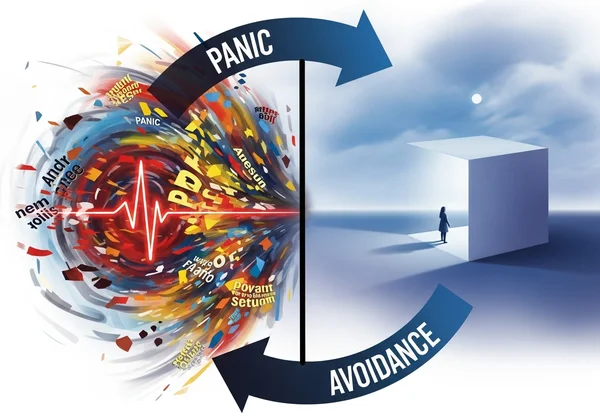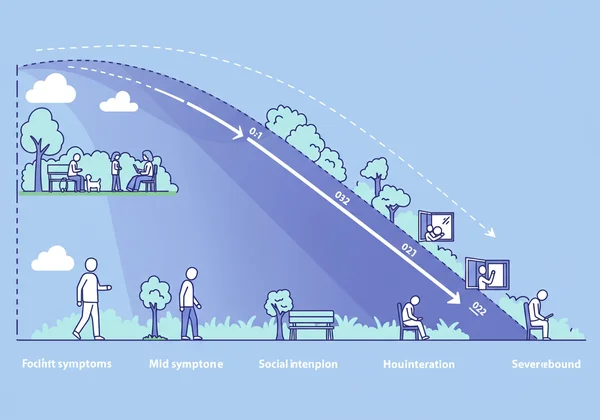Agoraphobia Test: Symptoms, Causes & Insights into Your Anxiety
When you hear 'agoraphobia,' you might picture someone unable to step outside. But this complex anxiety disorder is far more than just a fear of open spaces. It's a deep-seated fear and anxiety about situations where escaping might be difficult, or where help feels out of reach if panic strikes. If this sounds familiar, you're not alone. The journey to understanding its impact often starts with a simple question: How do you test for agoraphobia? This guide aims to shed light on this challenging condition, exploring its common causes, distinguishing it from other anxieties, and highlighting how a free agoraphobia test can be your first step towards clarity and understanding. If you're seeking to understand your own experiences or those of a loved one, a free and confidential agoraphobia test can provide valuable initial insights. Start your journey to understanding your symptoms today by taking a free assessment.

Understanding What Agoraphobia Truly Is About
Agoraphobia is often misunderstood, frequently confused with generalized anxiety or simple shyness. However, it's a distinct condition that profoundly impacts an individual's life, often leading to significant avoidance behaviors.
Beyond Open Spaces: Common Agoraphobia Symptoms & Triggers
Agoraphobia isn't just about fear of wide-open spaces; it involves a cluster of anxieties related to specific situations. Individuals often experience fear in at least two of the following five situations: public transportation (buses, trains, planes), open spaces (parking lots, marketplaces, bridges), enclosed spaces (shops, theaters, cinemas), standing in line or being in a crowd, and being outside of the home alone. The agoraphobia symptoms can include intense fear, dread, helplessness, or embarrassment. These situations become triggers because they are perceived as difficult to escape or where help might be unavailable during a panic attack or other distressing symptoms. Recognizing these signs of agoraphobia is crucial for self-awareness.
The Diagnostic Criteria for Agoraphobia (DSM-5 Overview)
Understanding the professional framework for diagnosing agoraphobia can offer significant clarity. According to the Diagnostic and Statistical Manual of Mental Disorders, Fifth Edition (DSM-5), agoraphobia diagnosis criteria involve marked fear or anxiety about situations where escape might be difficult or help unavailable if panic-like symptoms or other incapacitating symptoms occur. These situations almost always provoke fear or anxiety and are actively avoided, or endured with intense distress. The fear is out of proportion to the actual danger, and it persists, typically for 6 months or more, causing clinically significant distress or impairment in social, occupational, or other important areas of functioning. While only a professional can provide a diagnosis, understanding these criteria can help you identify if your experiences align, guiding your decision to seek support or take a preliminary online agoraphobia test. A comprehensive agoraphobia test can help you recognize patterns.
What Causes Agoraphobia? Exploring Potential Roots
The development of agoraphobia is often complex, involving a combination of genetic, environmental, and psychological factors. Pinpointing what causes agoraphobia can be a challenging but enlightening process for individuals seeking to understand their condition.
The Role of Panic Attacks in Developing Agoraphobia
A significant number of individuals with agoraphobia also experience panic disorder, where recurrent unexpected panic attacks are a central feature. For many, agoraphobia develops as a direct consequence of experiencing debilitating panic attacks in specific situations. The fear of having another panic attack can lead to avoidance of places where previous attacks occurred, or places perceived as potential triggers. This often starts a cycle where fear of panic fuels avoidance, which then reinforces the agoraphobic behaviors. Understanding the link between panic attacks and agoraphobia is vital for effective intervention.

Risk Factors: Genetics, Trauma, and Other Influences
Beyond panic attacks, several other risk factors can contribute to the development of agoraphobia. These include a genetic predisposition, meaning a family history of anxiety disorders or agoraphobia may increase vulnerability. Traumatic events, such as experiencing a severe illness, an accident, or an assault, can also precede the onset of agoraphobia. Other influences might include a history of other anxiety disorders, stressful life events, or even certain personality traits, such as neuroticism. Exploring the potential root cause of agoraphobia for an individual often requires a holistic view of their life experiences and personal history.
Agoraphobia vs. Panic Disorder: Key Differences & Overlaps
It's common for individuals to confuse agoraphobia with panic disorder, and while they frequently coexist, they are distinct conditions. Understanding the nuances of agoraphobia vs panic disorder is essential for proper identification and support.
When Agoraphobia and Panic Attacks Coexist
As mentioned, many people with agoraphobia also experience panic disorder. In these cases, the agoraphobia develops as a response to the fear of having future panic attacks. The individual begins to avoid situations and places where they might experience a panic attack, leading to a shrinking world. However, it's important to note that agoraphobia can occur without a history of panic attacks. In such instances, the fear is primarily of the incapacitating or embarrassing symptoms themselves, rather than specific panic attacks. Understanding if your experiences align with the criteria for a panic attack vs agoraphobia can be the first step towards seeking the right support.
Distinguishing Agoraphobia from Other Anxiety Conditions
Agoraphobia can sometimes be mistaken for other anxiety conditions like social anxiety disorder or specific phobias. Social anxiety primarily involves fear of social situations due to concerns about being judged or scrutinized, whereas agoraphobia is more about the inability to escape a situation or access help. Specific phobias, like claustrophobia, are fears of particular objects or situations (e.g., enclosed spaces), but agoraphobia involves a broader fear of multiple situations. A key differentiator in an anxiety disorders comparison is the underlying fear of being trapped or helpless, which is central to agoraphobia. For clarity on your specific concerns, consider a private self-assessment.
Types of Agoraphobia and Its Spectrum
Agoraphobia doesn't always present in the same way; its severity and the situations it affects can vary widely from person to person. Exploring the types of agoraphobia helps us understand its diverse impact.
Is There a Spectrum for Agoraphobia?
Yes, agoraphobia exists on a spectrum for agoraphobia. Some individuals might experience mild symptoms, leading to avoidance of only a few specific situations, such as crowded concerts or long bus rides. Others may find their world severely limited, becoming housebound and unable to leave their home without extreme distress or the presence of a trusted companion. The impact on daily life directly correlates with where one falls on this spectrum. Recognizing this range is important, as even mild symptoms can escalate if left unaddressed. To better understand where your experiences might fall, a detailed agoraphobia screening test or a broader agoraphobia test can offer initial insights.

Living with Agoraphobia: Common Challenges & Daily Impact
Living with agoraphobia presents unique and profound challenges. Simple tasks most people take for granted – like grocery shopping, commuting to work, or visiting loved ones – become immense hurdles. This can lead to social isolation, dependence on others, and significant emotional distress, including feelings of shame, guilt, or depression. What is life like with agoraphobia for someone severely affected? It can mean a dramatically reduced quality of life, where the home becomes a perceived sanctuary but also a prison. However, it’s vital to remember that recovery and management are possible with appropriate support and strategies.
Your Journey to Understanding Agoraphobia Begins Here
Taking that first step towards understanding agoraphobia, its symptoms, and its causes is a powerful act of regaining control. While this article offers a comprehensive overview, your personal experience is uniquely valuable. If you recognize these patterns in yourself or a loved one, know that clarity is within reach. A scientifically-informed agoraphobia test can provide a confidential, quick, and free initial assessment, offering the insight you need to understand your situation better. This platform provides exactly this: a free, quick, and confidential online tool designed to help you assess your agoraphobia symptoms. It’s based on established psychological criteria and offers instant, preliminary risk assessments, giving you a preliminary agoraphobia test result. For deeper insights, you can opt for an AI-driven personalized analysis report that highlights specific patterns and potential coping strategies. Remember, this isn't a diagnostic tool, but a supportive first step to help you understand your situation better and empower you to decide on your next actions. Don't navigate this alone—take a free, empowering agoraphobia test today to gain some clarity.

Frequently Asked Questions About Agoraphobia
Navigating the complexities of agoraphobia often comes with many questions. Here are some common inquiries that can help deepen your understanding.
How do I tell if I'm developing agoraphobia?
If you notice increasing anxiety or panic in situations where escape might be difficult or help unavailable, and you start avoiding these situations, these could be signs of agoraphobia. These situations typically include public transportation, open spaces, enclosed spaces, crowds, or being outside alone. Your fear might feel disproportionate to the actual threat, and it significantly impacts your daily routine or social life. A quick and confidential agoraphobia test can provide an initial indication.
Can you be agoraphobic and still leave the house?
Yes, absolutely. The severity of agoraphobia varies. Some individuals may still be able to leave their homes, but only with extreme distress, when accompanied by a trusted person, or for very short distances. Their fear is often context-dependent, meaning they might tolerate certain situations while severely avoiding others. The presence of agoraphobia doesn't automatically mean being housebound; it signifies a spectrum of avoidance and fear.
What can agoraphobia be mistaken for?
Agoraphobia is sometimes mistaken for social anxiety disorder, specific phobias (like claustrophobia or fear of heights), or even generalized anxiety disorder. While there can be overlaps, the key distinguishing factor for agoraphobia is the fear of being in situations from which escape is difficult or help is unavailable, coupled with avoidance behaviors. A specialized agoraphobia screening test or a comprehensive agoraphobia test can help differentiate these conditions by focusing on the specific fears and avoidance patterns characteristic of agoraphobia.
Can you suddenly get agoraphobia?
While agoraphobia often develops gradually, often following a period of recurrent panic attacks, its onset can feel sudden. In some cases, a severe traumatic event or a particularly debilitating panic attack can trigger a rapid onset of agoraphobic symptoms and avoidance behaviors. However, even in these instances, there might be underlying vulnerabilities that were previously unnoticed. Regardless of how it starts, recognizing the symptoms early can pave the way for effective support. To explore your symptoms further, feel free to try our free agoraphobia test.